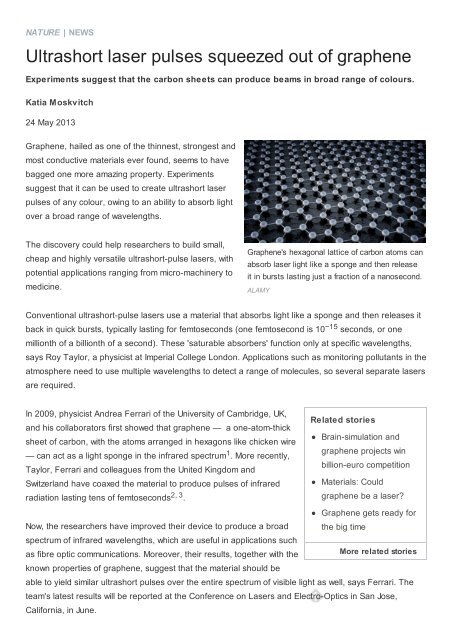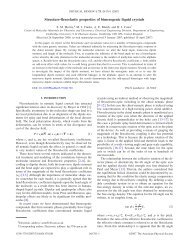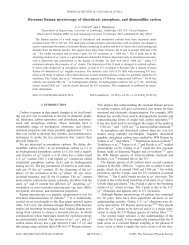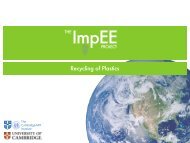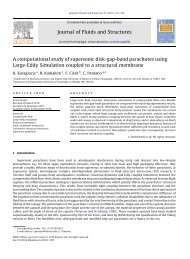Ultrashort laser pulses squeezed out of graphene - G.eng.cam.ac.uk
Ultrashort laser pulses squeezed out of graphene - G.eng.cam.ac.uk
Ultrashort laser pulses squeezed out of graphene - G.eng.cam.ac.uk
Create successful ePaper yourself
Turn your PDF publications into a flip-book with our unique Google optimized e-Paper software.
NATURE | NEWS<br />
<strong>Ultrashort</strong> <strong>laser</strong> <strong>pulses</strong> <strong>squeezed</strong> <strong>out</strong> <strong>of</strong> <strong>graphene</strong><br />
Experiments suggest that the carbon sheets can produce beams in broad range <strong>of</strong> colours.<br />
Katia Moskvitch<br />
24 May 2013<br />
Graphene, hailed as one <strong>of</strong> the thinnest, strongest and<br />
most conductive materials ever found, seems to have<br />
bagged one more amazing property. Experiments<br />
suggest that it can be used to create ultrashort <strong>laser</strong><br />
<strong>pulses</strong> <strong>of</strong> any colour, owing to an ability to absorb light<br />
over a broad range <strong>of</strong> wavel<strong>eng</strong>ths.<br />
The discovery could help researchers to build small,<br />
cheap and highly versatile ultrashort-pulse <strong>laser</strong>s, with<br />
potential applications ranging from micro-m<strong>ac</strong>hinery to<br />
medicine.<br />
Graphene's hexagonal lattice <strong>of</strong> carbon atoms can<br />
absorb <strong>laser</strong> light like a sponge and then release<br />
it in bursts lasting just a fr<strong>ac</strong>tion <strong>of</strong> a nanosecond.<br />
ALAMY<br />
Conventional ultrashort-pulse <strong>laser</strong>s use a material that absorbs light like a sponge and then releases it<br />
b<strong>ac</strong>k in quick bursts, typically lasting for femtoseconds (one femtosecond is 10 −15 seconds, or one<br />
millionth <strong>of</strong> a billionth <strong>of</strong> a second). These 'saturable absorbers' function only at specific wavel<strong>eng</strong>ths,<br />
says Roy Taylor, a physicist at Imperial College London. Applications such as monitoring pollutants in the<br />
atmosphere need to use multiple wavel<strong>eng</strong>ths to detect a range <strong>of</strong> molecules, so several separate <strong>laser</strong>s<br />
are required.<br />
In 2009, physicist Andrea Ferrari <strong>of</strong> the University <strong>of</strong> Cambridge, UK,<br />
Related stories<br />
and his collaborators first showed that <strong>graphene</strong> — a one-atom-thick<br />
Brain-simulation and<br />
sheet <strong>of</strong> carbon, with the atoms arranged in hexagons like chicken wire<br />
<strong>graphene</strong> projects win<br />
— can <strong>ac</strong>t as a light sponge in the infrared spectrum 1 . More recently,<br />
billion-euro competition<br />
Taylor, Ferrari and colleagues from the United Kingdom and<br />
Switzerland have coaxed the material to produce <strong>pulses</strong> <strong>of</strong> infrared Materials: Could<br />
radiation lasting tens <strong>of</strong> femtoseconds 2, 3 .<br />
<strong>graphene</strong> be a <strong>laser</strong>?<br />
Graphene gets ready for<br />
Now, the researchers have improved their device to produce a broad the big time<br />
spectrum <strong>of</strong> infrared wavel<strong>eng</strong>ths, which are useful in applications such<br />
as fibre optic communications. Moreover, their results, together with the<br />
More related stories<br />
known properties <strong>of</strong> <strong>graphene</strong>, suggest that the material should be<br />
able to yield similar ultrashort <strong>pulses</strong> over the entire spectrum <strong>of</strong> visible light as well, says Ferrari. The<br />
team's latest results will be reported at the Conference on Lasers and Electro-Optics in San Jose,<br />
California, in June.
On–<strong>of</strong>f switch<br />
Graphene’s ability to absorb light <strong>of</strong> any colour comes from the peculiar structure <strong>of</strong> the energy levels <strong>of</strong><br />
its electrons. In a typical solid non-metal material, electrons can exist in a low-energy state, in which they<br />
are bound to atoms, or in a higher-energy state, where they are able to move around and carry an<br />
electric current. Between these two states is a 'band gap', which requires a certain energy to be bridged.<br />
An electron can cross the band gap if the material absorbs light with that particular energy — which<br />
means a particular wavel<strong>eng</strong>th. In the semiconductor materials used to make transistors in computer<br />
chips, electrons jumping over the band gap switch the current from '<strong>of</strong>f' to 'on'.<br />
In <strong>graphene</strong>, by contrast, there is no band gap, and the electrons' energy can vary along a continuum.<br />
That makes single-sheet <strong>graphene</strong> useless in transistors, says Byung Hee Hong, a physicist at Seoul<br />
National University, but it gives the material an advantage in optics, enabling it to absorb a wide range <strong>of</strong><br />
wavel<strong>eng</strong>ths <strong>of</strong> light.<br />
“Usually, different materials are needed for different wavel<strong>eng</strong>ths, and there are not many [conventional]<br />
materials that can be used for the near-infrared region,” says Hong, who was not involved in the new<br />
study.<br />
Graphene is also chemically and mechanically stable enough to prevent thermal damage by intense<br />
<strong>laser</strong> beams, Hong adds. And a major advantage <strong>of</strong> <strong>graphene</strong>-based ultrashort-pulse <strong>laser</strong>s is that these<br />
devices can be as small as a pencil, making them versatile and easy to use.<br />
Nature<br />
doi:10.1038/nature.2013.12911<br />
References<br />
1. Hasan, T. et al. Adv. Mat. 21, 3874 (2009).<br />
Show context<br />
2. Lagatsky, A. A. et al. Appl. Phys. Lett. 102, 013113 (2013).<br />
Show context<br />
3. Mary, R. et al. Opt. Express 21, 7943–7950 (2013).<br />
Show context<br />
Article ChemPort<br />
Article ChemPort<br />
Article PubMed ChemPort<br />
Related stories and links<br />
From nature.com<br />
Brain-simulation and <strong>graphene</strong> projects win billion-euro competition<br />
23 January 2013<br />
Materials: Could <strong>graphene</strong> be a <strong>laser</strong>?<br />
25 April 2012<br />
Graphene gets ready for the big time
25 March 2009<br />
Nature Outlook: Graphene<br />
For the best commenting experience, please login or register as a user and agree to our Community<br />
Guidelines. You will be re-directed b<strong>ac</strong>k to this page where you will see comments updating in real-time<br />
and have the ability to recommend comments to other users.<br />
Comments<br />
Subscribe to comments<br />
There are currently no comments.<br />
See other News & Comment articles from Nature<br />
Nature ISSN 0028-0836 EISSN 1476-4687<br />
© 2013 Nature Publishing Group, a division <strong>of</strong> M<strong>ac</strong>millan Publishers Limited. All Rights Reserved.<br />
partner <strong>of</strong> AGORA, HINARI, OARE, INASP, CrossRef and COUNTER


